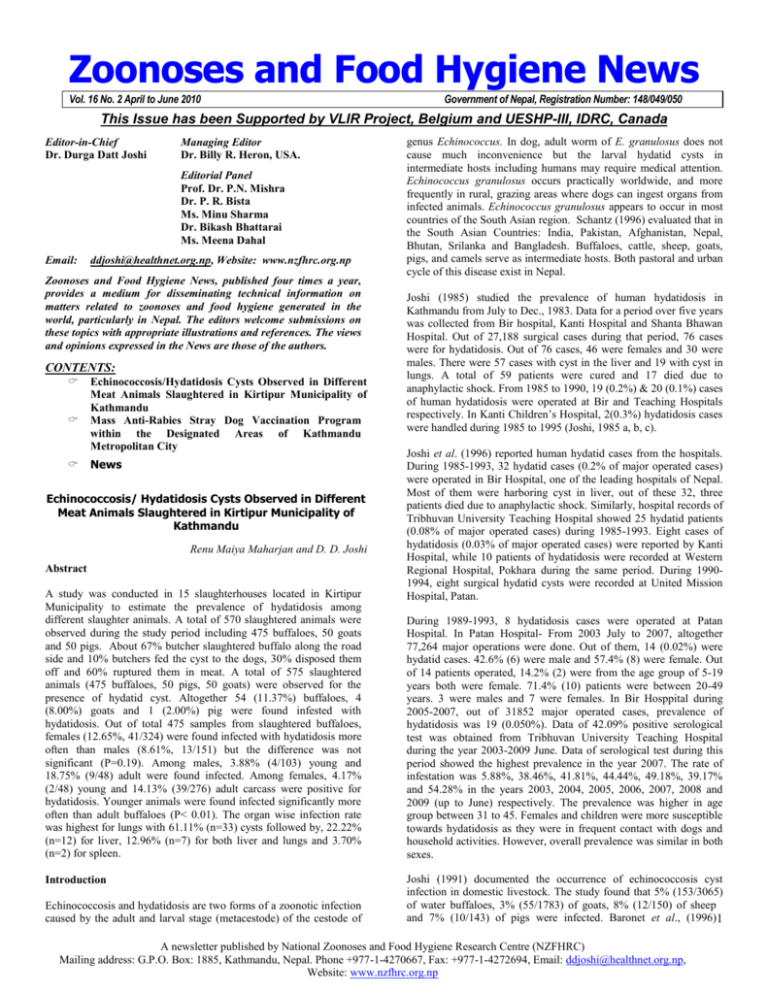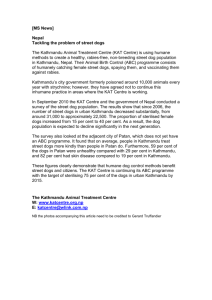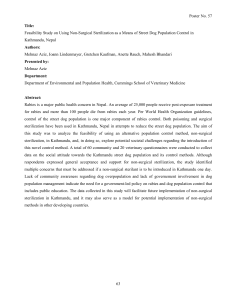V16N2 - National Zoonoses and Food Hygiene Research Centre
advertisement

Zoonoses and Food Hygiene News Vol. 16 No. 2 April to June 2010 Government of Nepal, Registration Number: 148/049/050 This Issue has been Supported by VLIR Project, Belgium and UESHP-III, IDRC, Canada Editor-in-Chief Dr. Durga Datt Joshi Managing Editor Dr. Billy R. Heron, USA. Editorial Panel Prof. Dr. P.N. Mishra Dr. P. R. Bista Ms. Minu Sharma Dr. Bikash Bhattarai Ms. Meena Dahal Email: ddjoshi@healthnet.org.np, Website: www.nzfhrc.org.np Zoonoses and Food Hygiene News, published four times a year, provides a medium for disseminating technical information on matters related to zoonoses and food hygiene generated in the world, particularly in Nepal. The editors welcome submissions on these topics with appropriate illustrations and references. The views and opinions expressed in the News are those of the authors. CONTENTS: Echinococcosis/Hydatidosis Cysts Observed in Different Meat Animals Slaughtered in Kirtipur Municipality of Kathmandu Mass Anti-Rabies Stray Dog Vaccination Program within the Designated Areas of Kathmandu Metropolitan City News Echinococcosis/ Hydatidosis Cysts Observed in Different Meat Animals Slaughtered in Kirtipur Municipality of Kathmandu Renu Maiya Maharjan and D. D. Joshi Abstract A study was conducted in 15 slaughterhouses located in Kirtipur Municipality to estimate the prevalence of hydatidosis among different slaughter animals. A total of 570 slaughtered animals were observed during the study period including 475 buffaloes, 50 goats and 50 pigs. About 67% butcher slaughtered buffalo along the road side and 10% butchers fed the cyst to the dogs, 30% disposed them off and 60% ruptured them in meat. A total of 575 slaughtered animals (475 buffaloes, 50 pigs, 50 goats) were observed for the presence of hydatid cyst. Altogether 54 (11.37%) buffaloes, 4 (8.00%) goats and 1 (2.00%) pig were found infested with hydatidosis. Out of total 475 samples from slaughtered buffaloes, females (12.65%, 41/324) were found infected with hydatidosis more often than males (8.61%, 13/151) but the difference was not significant (P=0.19). Among males, 3.88% (4/103) young and 18.75% (9/48) adult were found infected. Among females, 4.17% (2/48) young and 14.13% (39/276) adult carcass were positive for hydatidosis. Younger animals were found infected significantly more often than adult buffaloes (P< 0.01). The organ wise infection rate was highest for lungs with 61.11% (n=33) cysts followed by, 22.22% (n=12) for liver, 12.96% (n=7) for both liver and lungs and 3.70% (n=2) for spleen. Introduction Echinococcosis and hydatidosis are two forms of a zoonotic infection caused by the adult and larval stage (metacestode) of the cestode of genus Echinococcus. In dog, adult worm of E. granulosus does not cause much inconvenience but the larval hydatid cysts in intermediate hosts including humans may require medical attention. Echinococcus granulosus occurs practically worldwide, and more frequently in rural, grazing areas where dogs can ingest organs from infected animals. Echinococcus granulosus appears to occur in most countries of the South Asian region. Schantz (1996) evaluated that in the South Asian Countries: India, Pakistan, Afghanistan, Nepal, Bhutan, Srilanka and Bangladesh. Buffaloes, cattle, sheep, goats, pigs, and camels serve as intermediate hosts. Both pastoral and urban cycle of this disease exist in Nepal. Joshi (1985) studied the prevalence of human hydatidosis in Kathmandu from July to Dec., 1983. Data for a period over five years was collected from Bir hospital, Kanti Hospital and Shanta Bhawan Hospital. Out of 27,188 surgical cases during that period, 76 cases were for hydatidosis. Out of 76 cases, 46 were females and 30 were males. There were 57 cases with cyst in the liver and 19 with cyst in lungs. A total of 59 patients were cured and 17 died due to anaphylactic shock. From 1985 to 1990, 19 (0.2%) & 20 (0.1%) cases of human hydatidosis were operated at Bir and Teaching Hospitals respectively. In Kanti Children’s Hospital, 2(0.3%) hydatidosis cases were handled during 1985 to 1995 (Joshi, 1985 a, b, c). Joshi et al. (1996) reported human hydatid cases from the hospitals. During 1985-1993, 32 hydatid cases (0.2% of major operated cases) were operated in Bir Hospital, one of the leading hospitals of Nepal. Most of them were harboring cyst in liver, out of these 32, three patients died due to anaphylactic shock. Similarly, hospital records of Tribhuvan University Teaching Hospital showed 25 hydatid patients (0.08% of major operated cases) during 1985-1993. Eight cases of hydatidosis (0.03% of major operated cases) were reported by Kanti Hospital, while 10 patients of hydatidosis were recorded at Western Regional Hospital, Pokhara during the same period. During 19901994, eight surgical hydatid cysts were recorded at United Mission Hospital, Patan. During 1989-1993, 8 hydatidosis cases were operated at Patan Hospital. In Patan Hospital- From 2003 July to 2007, altogether 77,264 major operations were done. Out of them, 14 (0.02%) were hydatid cases. 42.6% (6) were male and 57.4% (8) were female. Out of 14 patients operated, 14.2% (2) were from the age group of 5-19 years both were female. 71.4% (10) patients were between 20-49 years. 3 were males and 7 were females. In Bir Hosppital during 2005-2007, out of 31852 major operated cases, prevalence of hydatidosis was 19 (0.050%). Data of 42.09% positive serological test was obtained from Tribhuvan University Teaching Hospital during the year 2003-2009 June. Data of serological test during this period showed the highest prevalence in the year 2007. The rate of infestation was 5.88%, 38.46%, 41.81%, 44.44%, 49.18%, 39.17% and 54.28% in the years 2003, 2004, 2005, 2006, 2007, 2008 and 2009 (up to June) respectively. The prevalence was higher in age group between 31 to 45. Females and children were more susceptible towards hydatidosis as they were in frequent contact with dogs and household activities. However, overall prevalence was similar in both sexes. Joshi (1991) documented the occurrence of echinococcosis cyst infection in domestic livestock. The study found that 5% (153/3065) of water buffaloes, 3% (55/1783) of goats, 8% (12/150) of sheep and 7% (10/143) of pigs were infected. Baronet et al., (1996)1 A newsletter published by National Zoonoses and Food Hygiene Research Centre (NZFHRC) Mailing address: G.P.O. Box: 1885, Kathmandu, Nepal. Phone +977-1-4270667, Fax: +977-1-4272694, Email: ddjoshi@healthnet.org.np, Website: www.nzfhrc.org.np studied prevalence, incidence and risk factors or infection by E. granulosus in the domestic and street dogs of Kathmandu using ELISA Coproantigen test as a screening method. The highest prevalence (5/88=5.7%) was seen in domestic dogs. Joshi (1996) reported 18% buffaloes, 9% sheep, 4% goats and 9% pigs positive for hydatid cyst from a study conducted among 18,805 slaughtered animals during 1993-1995. Livers and lungs were found equally affected and in some animals, both liver and lungs were found positive (Joshi et al., 1996). Hydatidosis is one of the neglected diseases which needs proper attention from all sectors to prevent the hazard of this disease in the future. Objectives The objective of this research is to estimate the prevalence and some features of hydatidosis in different slaughter animals. Methodology Study area Including 12 for buffaloes, a total of 15 slaughterhouses located in different wards of Kirtipur Municipality were included in the survey. Study Population A total of 570 slaughtered animals were observed during the study period including 475 buffaloes, 50 goats and 50 pigs. Among buffaloes 307 were male (243 adult and 64 young) and 168 were female (145 adult and 23 young). Results and Discussion Condition of slaughterhouses was very poor. 66.66% butcher slaughtered buffaloes along the road side. Only 33.33% butchers slaughtered animals in slaughterhouses. The study showed that 10% butchers immediately feed the cyst to the dogs to hide the cyst from consumers, 30% disposed the cyst with other waste, and 60% ruptured the cyst in meat to be sent for selling. Availability of cysts to dogs for ingestion indicates a continuous cycle echinococcosis and hydatidosis due to transmission between dogs to grazing animals. Similarly, unorganized waste management might again allow access of dogs to cysts disposed with other waste. Some consumers provide raw meat to their pet dogs. Ruptured cysts with active scolices in meat are risk to the pets and subsequently to their owners. During the study period, 575 animals (475 buffaloes, 50 pigs, 50 goats) slaughtered in Kirtipur Municipality were observed for the presence of hydatid cyst. 54 (11.37%) buffaloes, 4 (8.00%) goats and 1 (2.00%) pig were found infested with hydatidosis. Although this is a limited sample, this situation can be extrapolated to other slaughterhouses in the Kathmandu valley which share the same source of slaughter animals. These findings are higher than previous findings by Joshi (1991) but lower than Joshi (1996) and still indicate a public health threat. Out of total 475 samples from slaughtered buffaloes, females (12.65%, n=41) were found infected with Echinococcus more often than males (8.61%, n=13) but the difference was not significant (χ2=1.67, P=0.19, d.f.=1). Among males, 3.88% (4 of 103) young and 18.75% (9 of 48) adult carcasses were found infected. Among females, 4.17% (2 of 48) young and 14.13% (39 of 276) adult carcasses were positive for hydatidosis. Adult animals had a significantly higher risk of hydatidosis (χ2=12.01 P< 0.01, d.f.=1). This might be due to a higher risk of exposure to the parasite with increasing age and also that cyst development is slow and asymptomatic in the initial stages. The organ wise infection rate was highest for lungs with 61.11% (n=33) followed by,22.22% (n=12) for liver, 12.96% (n=7) for both liver and lungs and 3.70% (n=2) for spleen. References: Baronet, D., Waltner, Towes, D., Craig, P.S., and Joshi, D.D. 1993. E. granulosus infestations in dog populations of Kathmandu Nepal. Joshi D D (1985b) Echinococcosis/Hydatidosis infection in animals of Kathmandu. Bull. Vet. Sc. & A. H. Nepal. Vol. 13, pp 5-9. Joshi DD (1985c) Epidemiological survey of human echinococcosis/hydatidosis in Kathmandu. All Nepal Medical Conference (12:1985 Mar 20-23: Kathmandu). Vol. 23. 1. J Nep Med Assoc 1985 Jan-Mar; 23(1):1.27-1.35. Joshi, A. B., Joshi, D. D. and Wald Alan 1996. Epidemiological Assessment of echinococcosis in Nepal, Abstract, National Seminar on echinococcosis/hydatidosis organized by NZFHRC and IDRC Ottawa, Canada. Joshi, D D (1985a) Epidemiological Survey of Human Echinococcosis/Hydatidosis in Kathmandu. Proceedings of the Twelfth All Nepal Medical Conference. pp 1.27-1.35. Joshi, D. D. 1991. Organization of Veterinary Public Health in South Asia Region. Review of Science & Technology of the Office International Epizooties. 10: 1101-1129. Joshi, D. D. 1996. Surveillance of echinococcosis/hydatidosis in animals and humans of Kathmandu, Nepal. Report on WHO supported project on epidemiological surveillance of humans and animals for echinococcosis/hydatidosis Jan. 23-24 Kathmandu, Nepal, 49: 48-53. Joshi, D. D., Joshi, A. B. and Joshi, H. 1995. Epidemiology of echinococcosis in Nepal. Presented at 2nd Seminar on Epidemiology, Food Safety & Control. December 6-9, Khan Khen, Thailand. Schantz, P.M. 1996. Epidemiology of cystic echinococcosis: Global distribution and patterns of transmission. Division of parasitic disease National Central for Infectious Control and Prevention, Atlanta, Georgia, 30333 USA. Proceedings of National Seminar on echinococcosis/hydatidosis. January 2-24,1996, Katmandu. Nepal. Mass Anti-Rabies Stray Dog Vaccination Program within the Designated Areas of Kathmandu Metropolitan City By: AGRCN Background Rabies has been endemic in Nepal since antiquity. The disease is prevalent throughout the country and outbreaks are reported from time to time with the higher incidence during autumn and spring. With the aim to control the animal-rabies phenolyzed brain tissue vaccine production was initiated in 1970 in Nepal. In those days only a few thousand milliliters of vaccine were produced annually. Later from the year 1982, beta propiolactone (BPL) inactivated 5% sheep brain vaccine production was initiated for human use as post bite treatment for rabies. Currently, tissue culture vaccines are available for animals and humans. Rabies in Nepal is maintained mainly in two interrelated cycles, namely urban and sylvatic. The stray dogs are the major source of urban cycle of rabies. The population of such stray dog is estimated to be around 1.45 million in the whole country. Of them, nearly 90% are found in urban and sub-urban areas. The sylvatic cycle of rabies is maintained in the wild animals like jackals, wolves and2 A newsletter published by National Zoonoses and Food Hygiene Research Centre (NZFHRC) Mailing address: G.P.O. Box: 1885, Kathmandu, Nepal. Phone +977-1-4270667, Fax: +977-1-4272694, Email: ddjoshi@healthnet.org.np, Website: www.nzfhrc.org.np mongoose. When these wild animals come in contact with stray dogs, usually at garbage collection places, the disease in transmitted to the urban cycle through them. The distribution pattern of rabies in domestic animals is not similar throughout the country. More outbreaks usually occur in the hills and mountains than in the Terai districts, but the reason for this has not been fully understood. It could be due to contact with wild carnivores very frequently in hills and high hills as they are usually sparsely populated. There have been no joint efforts from any institution and agencies to control and eradicate canine and human rabies from the country. It was in 2006, WHO-Nepal very kindly initiated a Street Dog Survey in 3 cities of Nepal. a) Kathmandu b) Janakpur and c) Biratnagar The purpose was to determine the population size and population density of dogs on the streets of Kathmandu which would allow for effective monitoring of the effectiveness of any vaccination and population control measures implemented in the city and will allow for better targeting of these rabies control measures. Rabies has always been endemic in Kathmandu and a major public health issue. Several outbreaks occurred in 2008, and Kathmandu Animal Treatment (KAT) Centre responded to the cases. KAT also has a running dog population management program that is focused on neutering and vaccinating the female roaming dogs within the ring road of Kathmandu. Formation of Alliance Group for Rabies Control in Nepal (AGRCN) As per the survey it has been estimated that there are 20,500 street and community dogs within the ring road of Kathmandu city. A workshop was organized for building consensus amongst National Alliance Partners to develop the National Strategic Plan in Eliminating Canine Rabies in Nepal. With the aim to kick-start the rabies eradication program, an alliance has been formed by NGOs (2 member societies of WSPA, namely KAT and National Zoonoses and Food Hygiene Research Centre) and government bodies, namely the Kathmandu Metropolitan City and Veterinary Public Health Office in Kathmandu, Nepal to control and eradicate canine and human rabies from Kathmandu. The members of Alliance Group are: Public Health and Social Welfare Department Kathmandu Metropolitan City, Veterinary Public Health Office, Kathmandu Animal Treatment Centre and National Zoonoses and Food Hygiene Research Centre of The alliance for the Mass Anti-Rabies Vaccination Campaign is focused to provide parallel vaccination of male dogs and un-neutered females, and revaccination of the females that has gone through KAT, within KAT working areas. Objective to reduce rabies incidence by 50% (baseline 2007) by 5 years (short term) as accordance to the objective of the National Workshop recommendation. to establish strong linkage between government, and NGOs for rabies control. to celebrate "World Rabies Day – 2009" in Nepal. Major Strategic Approach Cost effective and Sustainable Mass Dog Vaccination Live rabies vaccine (with a potency of not less than 1.0 IU/dose) is recommended for dogs. For the identification of vaccinated animals, standard identification system will be adopted, which should be different in color from other tag system. The vaccination of 70% dog population is considered in order to create the buffer zone at least 5 kilometer wide along urban i.e. ring road border areas. In the absence of dog population control and mass dog vaccination, we estimated that the PET (Post Exposure Treatment) cases would increase by 4% every year with considerable increase in human rabies death at least by 4% every year. We also estimated that PET cases will decrease by 10% every year after 2nd year of mass dog vaccination due to decrease in incidence of rabies in dogs, resulting in less probability of being bitten by non-rabid dogs without provocation. Public health education Public health awareness program will be launched extensively for targeted groups in targeted areas. The information will be disseminated through media, FM stations (Metropolitan City FM service has very kindly offered to help us), distribution of leaflets, pamphlets etc. Dog population management through reduction methods The removal/killing of dogs does not create a significant impact on dog population densities or the spread of rabies. In addition, dog removal may be unacceptable to local communities. Hence, this approach should not be used in large-scale control program unless its feasibility is proved in ecological and socio-cultural studies. However, animal birth control program and proper disposal of garbage will be promoted. An animal welfare organization KAT Centre has been conducting sterilization and vaccination program on female population. There is a need to vaccinate male dogs within the community to reach the 70% threshold Methodology A team comprising each staff member from Kathmandu Metropolitan Public Health Department, Veterinary Public Health Department, Kathmandu Animal Treatment Centre and National Zoonoses and Food Hygiene Research Centre has been formed. The Alliance agreed to form a five member Management Committee under the leadership of the Chief Executive Officer of the Kathmandu Metropolitan City Office. The Committee is comprised of Chief, Public Health and Social Welfare Department, KMC Chief, Veterinary Public Health Office Director, Kathmandu Animal Treatment Centre Executive Chairman, National Zoonoses and Food Hygiene Research Centre Under the management committee actively working teams i.e. a) Monitoring and evaluation and b) Operating team were formed in order to vaccinate dogs and alongside to monitor to it. The monitoring and evaluation team was formed by the members of alliance group whereas in the operating team, three teams were formed with one veterinarian, two dog catchers and one logistic in each. The Alliance team selected the area and conducted the anti-rabies campaign block wise. KAT centre provided data on closest estimation of street and community dog to the Alliance. This information has helped the team to analyze the number of dogs to be vaccinated. 3 A newsletter published by National Zoonoses and Food Hygiene Research Centre (NZFHRC) Mailing address: G.P.O. Box: 1885, Kathmandu, Nepal. Phone +977-1-4270667, Fax: +977-1-4272694, Email: ddjoshi@healthnet.org.np, Website: www.nzfhrc.org.np Vaccination Program was started from the centre of the city and moved ever-widening to vaccinate dogs block wise so that very less percentage of dogs were missed out (Table-1). Nepal. He has presented following paper entitled “Zoonoses Parasitology (Parasitic Zoonoses)” during the workshop. NATIONAL EPIDEMIOLOGICAL CONFERENCE To conduct the Mass Anti-rabies Vaccination Program KAT Centre’s sterilization and vaccination working areas were selected. Prior to vaccination, the Alliance had organized short term training (3 days) to the operating team. The training was mainly focused on humanely catching of dog i.e. applying sack-capture method, maintaining records, identification/making for vaccinated dogs and briefing the protocol of mass anti-rabies vaccination campaign. In order to establish working understanding and multi phases procedure on agreement with multi partners, although agreement between WHO was five months prior, the vaccination program was only possible to start from 21st February 2009. A total of 10,000 stray and community dogs have been vaccinated against rabies as per target fixed (Table – 1). Table – 1: Vaccination coverage by teams Vaccinated Female Total 1320 3333 1418 3333 Type of dogs Stray Community 2442 891 2263 1017 The Nepal Health Research Council, together with the World Health Organization was organized the National Epidemiological Meeting in Kathmandu from 23-25 June 2010. The main objective of the Conference was to promote the role of epidemiology for public health action and to advocate for its application for national program development and management. Dr. Durga Datt Joshi, Executive Chairman of NZFHRC participated and presented a paper entitled “Epidemiology of Zoonotic Diseases” in this conference. LAND USE CHANGE AND HUMAN HEALTH IN EASTERN HIMALAYAN – AN ADAPTIVE ECOSYSTEM APPROACH Dr. Durga Datt Joshi, Executive Chairman of NZFHRC participated in the Mid-term Review Workshop of the project entitled "Land Use Change and Human Health in Eastern Himalayan – an Adaptive Ecosystem Approach" from June 28th – July 1st, 2010 Kathmandu, Nepal. This Workshop was organized by ICIMOD, Kathmandu, Nepal. He has presented a paper on "Urban Ecosystem Health Project in Kathmandu" during the workshop. Team A B Male 2013 1915 C 1841 1493 3334 2579 755 ECO HEALTH 2010 Total 5769 4231 10000 7284 2663 Dr. Durga Datt Joshi will participate in the Ecohealth 2010 conference in London from August 18 to 20, 2010. This is the third biennial conference of the International Association for Ecology and Health (IAEH). It will take place at and is hosted by the London School of Hygiene and Tropical Medicine and is generously supported by the International Development Research Centre (IDRC) Ottawa, Canada. NEWS: VETERINARY CONFERENCE 2010 (VETCON) Dr. Durga Datt Joshi, Executive Chairman of NZFHRC participated on the 9th National Veterinary Conference of Nepal Veterinary Association, VETCON 2010 from 22-24 April 2010 Kathmandu, Nepal. He presented two following papers during the conference: 1. 2. Seroprevalence of Porcine Cysticercosis and Human Taeniasis/Cysticercosis in Nepal Zoonoses and Human Health WORKSHOP ON ZOONOSES PARASITOLOGY (PARASITIC ZOONOSES) Dr. Durga Datt Joshi, Executive Chairman of NZFHRC has participated Workshop on Zoonoses Parasitology (Parasitic Zoonoses) 21st June 2010. This one day workshop was organized by Veterinary Public Health Department Tripureshwor, Kathmandu, A technical paper “Rebuilding Urban Ecosystem for Better Community Health in Kathmandu, Nepal” will be presented at the conference as an oral presentation. K.D.M.A. Research Award: Please kindly submit your research work paper on allergy for trust award consideration by the end of September 2010 to KDMART office Chagal, G.P.O. Box 1885, Kathmandu, Nepal, Phone: 4270667, 4274928 and Fax 4272694. This award was established by Dr. D.D. Joshi in 1992 (2049 B. S.) on the memory of his wife, the late Mrs. Kaushilya Devi Joshi. The award includes a grant of NCRs. 10,001 with certificate. From: Zoonoses & Food Hygiene News, NZFHRC P.O. Box 1885, Chagal, Kathmandu, Nepal. TO: Dr/Mr/Ms ........................................... ............................................................ ............................................................. 4 A newsletter published by National Zoonoses and Food Hygiene Research Centre (NZFHRC) Mailing address: G.P.O. Box: 1885, Kathmandu, Nepal. Phone +977-1-4270667, Fax: +977-1-4272694, Email: ddjoshi@healthnet.org.np, Website: www.nzfhrc.org.np








